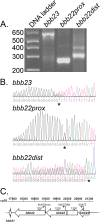Molecular dissection of a Borrelia burgdorferi in vivo essential purine transport system
- PMID: 25776752
- PMCID: PMC4432740
- DOI: 10.1128/IAI.02859-14
Molecular dissection of a Borrelia burgdorferi in vivo essential purine transport system
Abstract
The Lyme disease spirochete Borrelia burgdorferi is dependent on purine salvage from the host environment for survival. The genes bbb22 and bbb23 encode purine permeases that are essential for B. burgdorferi mouse infectivity. We now demonstrate the unique contributions of each of these genes to purine transport and murine infection. The affinities of spirochetes carrying bbb22 alone for hypoxanthine and adenine were similar to those of spirochetes carrying both genes. Spirochetes carrying bbb22 alone were able to achieve wild-type levels of adenine saturation but not hypoxanthine saturation, suggesting that maximal hypoxanthine uptake requires the presence of bbb23. Moreover, the purine transport activity conferred by bbb22 was dependent on an additional distal transcriptional start site located within the bbb23 open reading frame. The initial rates of uptake of hypoxanthine and adenine by spirochetes carrying bbb23 alone were below the level of detection. However, these spirochetes demonstrated a measurable increase in hypoxanthine uptake over a 30-min time course. Our findings indicate that bbb22-dependent adenine transport is essential for B. burgdorferi survival in mice. The bbb23 gene was dispensable for B. burgdorferi mouse infectivity, yet its presence was required along with that of bbb22 for B. burgdorferi to achieve maximal spirochete loads in infected mouse tissues. These data demonstrate that both genes, bbb22 and bbb23, are critical for B. burgdorferi to achieve wild-type infection of mice and that the differences in the capabilities of the two transporters may reflect distinct purine salvage needs that the spirochete encounters throughout its natural infectious cycle.
Copyright © 2015, American Society for Microbiology. All Rights Reserved.
Figures





References
-
- Casjens S, Palmer N, van Vugt R, Huang WM, Stevenson B, Rosa P, Lathigra R, Sutton G, Peterson J, Dodson RJ, Haft D, Hickey E, Gwinn M, White O, Fraser CM. 2000. A bacterial genome in flux: the twelve linear and nine circular extrachromosomal DNAs in an infectious isolate of the Lyme disease spirochete Borrelia burgdorferi. Mol Microbiol 35:490–516. doi:10.1046/j.1365-2958.2000.01698.x. - DOI - PubMed
-
- Fraser CM, Casjens S, Huang WM, Sutton GG, Clayton R, Lathigra R, White O, Ketchum KA, Dodson R, Hickey EK, Gwinn M, Dougherty B, Tomb J F, Fleischmann RD, Richardson D, Peterson J, Kerlavage AR, Quackenbush J, Salzberg S, Hanson M, van Vugt R, Palmer N, Adams MD, Gocayne J, Weidman J, Utterback T, Watthey L, McDonald L, Artiach P, Bowman C, Garland S, Fuji C, Cotton MD, Horst K, Roberts K, Hatch B, Smith HO, Venter JC. 1997. Genomic sequence of a Lyme disease spirochaete, Borrelia burgdorferi. Nature 390:580–586. doi:10.1038/37551. - DOI - PubMed
Publication types
MeSH terms
Substances
Grants and funding
LinkOut - more resources
Full Text Sources
Medical

